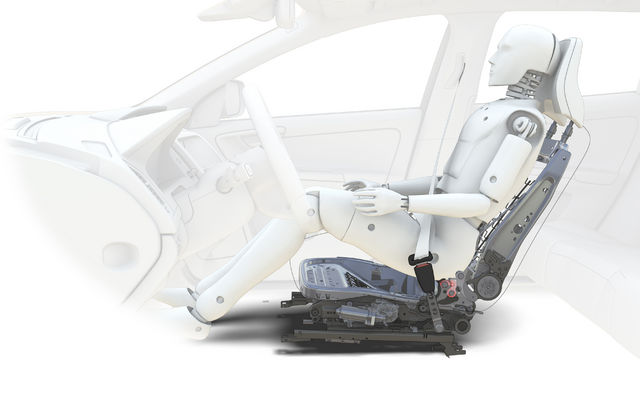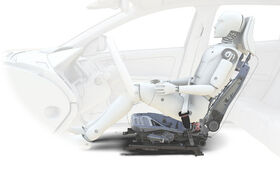Volvo Cars' whiplash system WHIPS celebrates 10 years
Whiplash injuries are among the most common of all traffic injuries. Volvo Cars was one of the earliest manufacturers to introduce proper protection aimed at reducing the risk of whiplash. Volvo's highly effective system, WHIPS, which halves the risk of long-term after-effects, is now celebrating ten years in operation.
"The Volvo S80 was the first car with WHIPS," says Lotta Jakobsson, safety expert and one of the people behind the development of WHIPS at Volvo Cars. That was back in 1998 and by 2000 WHIPS was fitted as standard in all Volvo's front seats.
"The system has undergone continuous refinement and development over the years and this year we are actually celebrating its tenth birthday," relates Lotta Jakobsson.
In an impact from the rear, immense force may be exerted on the vulnerable neck. The body is pushed forward and if the head does not accelerate together with the body, the neck can be over-stretched. Among the symptoms are pain from the neck area, headache and stiffness in the neck muscles. These symptoms usually disappear after a few weeks but in some cases they may last a long time.
"Proper whiplash protection should reduce the head's movement in relation to the upper body. The relative movement between different body parts should be as little as possible. Our unique WHIPS protection system has therefore been designed to distribute the incoming forces along the entire back and head and to dampen the path of the force by moving with the body," explains Lotta Jakobsson.
"The backrest accompanies the body's movement backward and tilts somewhat to the rear relative to the seat cushion. This reduces the force being exerted on the back and neck. What is more, Volvo's whiplash protection is positioned close to the head and high up, giving the head excellent support." "WHIPS have shown itself to be a very effective form of protection in rear-end collisions," relates Lotta Jakobsson. "Our own surveys show that the risk of sustaining long-term pain as a consequence of a rear-end impact is halved. Several external studies reveal similar results."
Decades of development
Since the early 1970s, Volvo's own accident research group has analysed actual traffic accidents to improve in-car safety. The experts soon realised that neck injuries were common in rear-end collisions.
Work was therefore launched on the development of a technical solution to protect the car's occupants from whiplash injuries. The result was a sturdy head restraint positioned high up against the head. Since the 1970s Volvo's cars have been fitted as standard with head restraints in the front seats.
During the 1980s and '90s several accident analyses and studies were undertaken together with medical experts to determine how the car could provide better protection for the neck in a rear-end impact. "In the early 1990s we developed what was at that time a unique computerised model of the human body. With the help of this model and our knowledge of real-life accidents, we could study the effects of different seat parameters on the spine's movement patterns. WHIPS was developed on the basis of these research results," explains Lotta Jakobsson.
Specially built crash test dummy helps the researchers
Lotta Jakobsson also relates that Volvo Cars was one of the developers behind the very first crash test dummy built for rear-end collisions, BioRID.
This dummy moves just like a human body does when hit from the rear. The resulting forces on the dummy's neck can be measured and the probable injury risk estimated.
The BioRID dummy was developed by the Swedish car industry and Chalmers University of Technology at the end of the 1990s. This unique dummy, which has since become standard equipment throughout the industry, has now had a production run of almost 100. "Our crash test dummy has had a huge effect on development since we can now conduct impact tests that are very authentic," says Lotta Jakobsson, who was the project manager on the BioRID development project. "The insurance industry has been using the dummy for the past five years to evaluate seats. Recently even EuroNCAP started using it in its rating system for seat protection against whiplash injuries."
Preventive safety systems are also highly effective
"Low-speed impacts from the rear are very common. Statistics reveal that more than 75 per cent of reported accidents take place at speeds below 30 km/h. In more than 50 per cent of these accidents, the car at the rear does not brake at all before hitting the vehicle in front. Here we have immense improvement potential," says Lotta Jakobsson.
"If we can help the driver brake in scenarios in which he or she is distracted, we will be able to save many necks. We are offering City Safety as standard in our latest car model, the XC60. If the driver is about to drive into the vehicle in front and does not respond in time, the car brakes automatically. The system is active at speeds below 30 km/h. Our aim is to ultimately develop cars that never collide. Until that vision is realised, however, we are proud to be able to offer one of the world's most effective protection systems against whiplash injuries," concludes Lotta Jakobsson.











